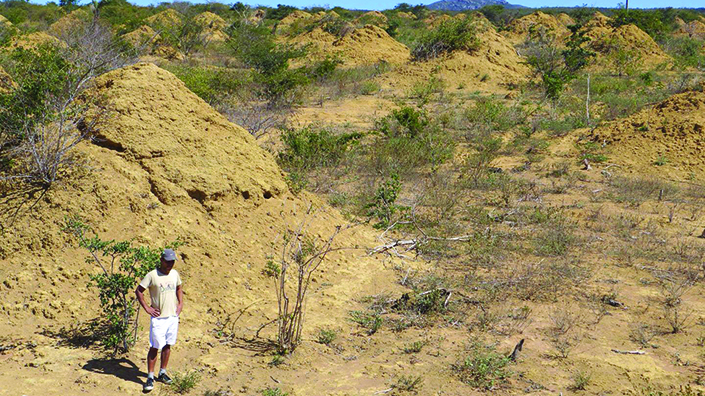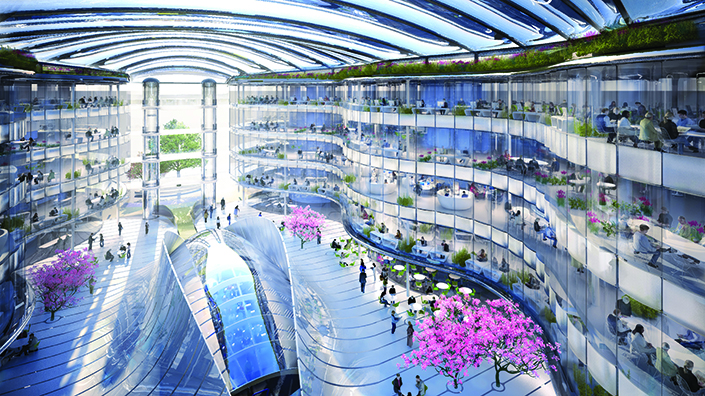Deep within the remote and semi-arid Caatinga shrubland of the country’s north east sit some 200 million cone-shaped termite mounds, each measuring around 2.5m high and 9m in diameter. The mounds, some of which date back almost 4,000 years, were built by a single termite species to grant access to a supply of leaves on the forest floor.
Although the mounds are spread across an area almost the size of Great Britain, scientists only became aware of their existence when the shrubland was cleared for livestock grazing in the past few decades. Ecologist Roy Funch, of Brazil’s Universidade Estadual de Feira de Santana, says the mounds are “the world’s most extensive bioengineering effort by a single insect species”.
Mound-building termites are found across South America, Australia and Africa, and they’ve been known to build structures as large as 30m wide. This is why human architects and engineers have long been fascinated with decoding how the insects work.
Learning from termites
In many cases, mounds serve as ventilation systems for the termite colonies that live below them. In 2015, a paper published by Harvard researchers in the journal PNAS showed that diurnal temperature oscillations drive cyclic flows that flush carbon dioxide out of the nests and ventilate the mounds of Odontotermes obesus termites.
Scientists had long suspected that termite mounds have unique ventilating properties, although the precise mechanism behind the effect was uncertain. Previous theories stated that internal heating from the nest or external wind-powered pressure shifts were the forces that displaced stale air.
Gas exchange
It’s now widely accepted that termite mounds facilitate a process similar to the gas exchange that occurs in the human lung. However, the mechanism of ventilation differs somewhat between location and termite species.
In the age of global heating, it’s only natural that architects want to design buildings that are more energy efficient. One way to do this is to reduce reliance on mechanical ventilation, such as fans and cooling systems. Here, termites have proven to be a source of inspiration.

Termite mound fields in Brazil (Credit: Roy Funch)
“Humans do what is called bulk ventilation,” explains Dr Rupert Soar, an associate professor in sustainable technologies at Nottingham Trent University, who has done field research on termites. “When we’ve got stale air in a room, we open a window and exchange all the air, or use mechanical ventilation. But then you take out all of the heat and moisture with it. The termite ventilation system seems to work without any bulk flow. It just mixes in pulses all the time.”
Biomimicry in architecture
Throughout history, people have turned to nature to help solve a variety of engineering problems. After all, plants and animals have developed advanced structures and building methods over the course of millions of years through the process of natural selection. This emulation of biological systems and processes is known as biomimicry, or biomimetics. One of the best-known examples of biomimicry in architecture is the Eastgate Centre, a termite-inspired shopping centre and office building opened in Harare, Zimbabwe in 1996.
Architect Mick Pearce designed the building to be ventilated and cooled by natural means – thereby avoiding the high costs associated with controlling temperature in a more traditional glass office block. First and foremost, the Eastgate Centre is made of concrete and brick, materials that boast a high thermal mass, meaning they absorb a lot of heat. This heat, along with the heat generated by the building’s occupants and machinery, helps to drive a thermosiphon flow through an extensive air-duct system. Warm air is ultimately pushed up and is drawn out via 48 brick chimney stacks.
Days in Harare are typically warm, but the heat stored in the Eastgate Centre’s fabric keeps its internal temperature relatively cool. Nights in the city tend to be chillier and, when the sun is down, high-volume fans are deployed to flush out the heat stored in the walls. Popular wisdom has it that the building drew its inspiration from the self-cooling mounds of African termites. But subsequent research by Soar and biologist J Scott Turner found that termite mounds don’t regulate temperature at all.
Small tunnels on the surface of the mounds – used as transit lanes by a colony’s many worker termites – block gusts of wind from the outside. Therefore, only gentle air movements can make it into the deepest part of the mound, where air is exchanged in a lung-like interchange. While the Eastgate Centre is not a true facsimile of the inner workings of a termite mound, Soar says it shares some important similarities with the real thing. “The thing that inspired Mick Pearce was getting all these ducts and channels into the building fabric itself,” he explains.
Energy and capital saved
Ultimately, the Eastgate Centre uses 35% less total energy than six similar buildings with conventional heating and cooling systems in Harare. The associated capital saving was estimated to be 10% of the building’s total cost. Given statistics like these – and the imperative to make the built environment more sustainable – it might seem surprising that biomimetic design principles aren’t ubiquitous in 2021. The problem, according to Michael Pawlyn, the founder of London-based biomimetic architecture firm Exploration Architecture and author of the book Biomimicry in Architecture, is in part owing to hesitation on the part of investors.
“Biomimicry innovation has certain advantages over other approaches – the main one being that biomimicry is based on ideas that have been proven to work in nature – but a lot of the ideas that emerge require proper R&D and that can be difficult within the constraints of a conventional project,” he says.
“The other major obstacle is that often we are able to propose solutions that are much better in the longer term – environmentally, economically and socially – but they are slightly more expensive in the short term.”
Pawlyn says his firm Exploration Architecture has devised a concept for a zero-waste and zero-carbon textiles factory that could deliver a six-year return on investment – and would be far cheaper to run after that. However, six years is widely considered too long a timescale to interest many would-be investors.
Inspiring beetle
The firm’s other projects include an “architectural complex” of self-sufficient desert greenhouses, which absorb water from the air through a network of roof-mounted grilles and condensers. This design, known as the Sahara Forest Project, was inspired by a beetle that uses its exoskeleton to condense the humidity in the air into enough water to survive. A pilot facility based on the concept opened in Qatar in 2012.
Exploration Architecture is also behind a concept study for a biomimetic office building modelled after the structure of a spookfish’s eye to maximise natural light. As Pawlyn sees it, many of the innovations needed to make the built environment more sustainable have already been designed by nature.

The Biomimetic Office Building concept (Credit: Exploration Architecture)
“There are lots of examples from biology that would allow us to deliver factor 10 or even factor 100 increases in resource efficiency,” he says. “Understanding planetary systems and ecosystem models also provides useful clues for how we should rethink our whole materials culture to eliminate waste and pollution.”
However, Soar believes that construction technologies must be programmed to behave more like insects or other animals for truly biomimetic concepts to be realised. The goal, in his view, is to create the next generation of 3D printers capable of sensing the environment in which they’re printing. Today’s additive manufacturing techniques simply deposit layers of material on top of each other. But robotic 3D printers with sensory capabilities could, in theory, modify what they’re printing to achieve a better effect.
“Design and function need to come together, and they come together through what we call processes – and these processes can be described through computer algorithms,” Soar explains. “Once you can look at an organism, such as a termite, and map how they build a mound, you can transfer that algorithm to a 3D printer and have it aggregate mud like termites would.”
Engineers still have a long way to go before their building techniques are as elegant as nature’s – and the climate and ecological crisis means that there’s some pressure to get on with it. In mimicking biological designs and ecosystems, we may just be able to preserve more of them.
Want the best engineering stories delivered straight to your inbox? The Professional Engineering newsletter gives you vital updates on the most cutting-edge engineering and exciting new job opportunities. To sign up, click here.
Content published by Professional Engineering does not necessarily represent the views of the Institution of Mechanical Engineers.